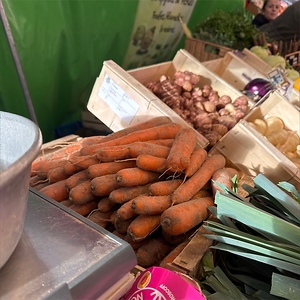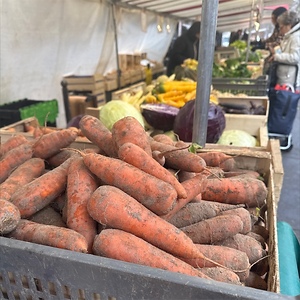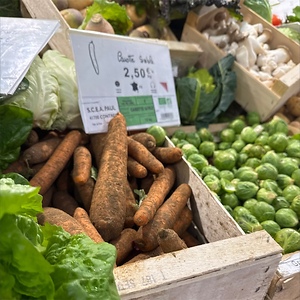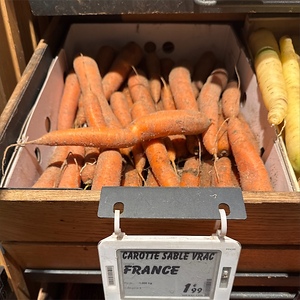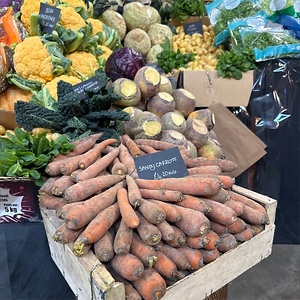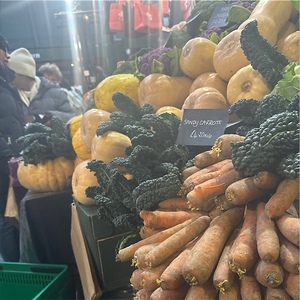


Sand Carrots
Estimated Inventory, lb : 0
Description/Taste
Sand carrots vary in size, depending on the age at harvest, and can range from 10 to 25 centimeters in length. The roots are known for their uniform, tapered shape and feature flat to sloping, curved shoulders and a narrow, blunt to pointed tip. Sand carrots are traditionally sold without their leafy green tops and are enveloped in a layer of sandy soil. Underneath the protective layer, the firm, semi-smooth, and hard skin is thin and covered in faint horizontal lines and striations. The root’s flesh is dense, solid, crisp, and crunchy. Sand carrots also lack a fibrous core commonly found in other varieties. The flesh is generally bright orange to orange-red, and this color extends through the entire root. Sand carrots are edible raw or cooked and are known for their tender but snappy consistency. Raw carrots have a fresh, delicate, and sweet taste with earthy, nutty, and lightly fruity nuances.
Seasons/Availability
Sand carrots are available in the late summer through spring.
Current Facts
Sand carrots, botanically classified as Daucus carota, are a distinct group of carrots belonging to the Apiaceae family. The name Sand carrot does not refer to a variety, but a specific method of cultivation practiced in select communities along the Atlantic coast of northwestern France. Sand carrots are also known as Carottes de Sables and Carotte de Créances in French and are a culinary delicacy valued for their uniform appearance, crunchy flesh, and sweet flavor. The root vegetables are sown in well-draining, subtly salty, and sandy soils, which allow the carrots to grow straight and even. Sand carrots are also fertilized by seaweed, and the plants are kissed by a salty sea breeze during cultivation, contributing to their sweeter flavor. In European markets, Sand carrots are sold with a layer of sandy soil intact on the surface as a preservation method and a symbol of their cultivation. The specialty roots are harvested by hand, and the tops are removed before packing in boxes to ship to markets. Sand carrot cultivation requires that they are shipped within five days to retain their quality, while other commercial carrots in France can be stored and shipped up to fifteen days later. Sand carrots are regarded as a gourmet culinary ingredient among chefs and home cooks throughout Europe and are a sought-after root vegetable for raw and cooked preparations.
Nutritional Value
Sand carrots are a source of potassium to balance fluid levels within the body and vitamins A and K to maintain healthy organs while aiding in faster wound healing. Carrots also provide some fiber to regulate the digestive tract and lower amounts of vitamins C and E to strengthen the immune system and guard the cells against the damage caused by free radicals. A distinct trait of Sand carrots is their high iodine content. Iodine helps the body produce protein to build nerves and hormones for overall thyroid health. Other nutrients may include copper, manganese, zinc, iron, magnesium, phosphorus, and calcium.
Applications
Sand carrots can be used in any recipe calling for standard commercial carrots and are favored for their sweet, subtly earthy taste. The carrots are edible raw or cooked and must be washed before incorporating into dishes. Once cleaned, Sand carrots can be trimmed, and it is up to the chef's preference whether they are peeled. Sand carrots can be eaten out of hand as a snack or sliced and served on crudité platters. They can also be chopped into salads, grated into slaws, incorporated into fresh spring rolls, or shredded and coated in a light vinaigrette. In addition to fresh preparations, Sand carrots are notably boiled until slightly soft and then tossed in spices and butter throughout France. The carrot’s sweet flavor is enhanced when cooked until glazed, and the term “Vichy-style” refers to cooking the roots in water and butter until tender. Sand carrots can also be pureed as a creamy base or used as a foundational ingredient in mirepoix. In French cuisine, Sand carrots are the choice root vegetable with braised stuffed pork and classic dishes like boeuf bourguignon, a beef-based stew, blanquette de veau, or a veal stew, and coq au vin, a chicken and red wine stew. In other regions of Europe, including London, Sand carrots are a seasonal delicacy incorporated into pies, roasts, and braises. The roots can be added to soups and curries, baked into gratins, or utilized in sweet dishes like carrot cake, cookies, and muffins. Sand carrots pair well with dried fruits like apricots and prunes, spices, including star anise, cumin, nutmeg, and coriander, fresh herbs like thyme, parsley, and rosemary, and citrus, including lemons and oranges. Sand carrots should be left with their soil coating until they are needed for use. The roots are best used within 4 to 5 days but may last for a week or two, depending on storage conditions and quality. It is recommended to store Sand carrots in the refrigerator's crisper drawer.
Ethnic/Cultural Info
Sand carrots are famously celebrated at the Fête de la Carotte, or the Carrot Festival, in the commune of Créances in Normandy, France. The festival was established in 1990 to promote and raise awareness around the signature carrots grown in the region. Sand carrots are locally known throughout Créances as the Carotte de Créances or the Créances carrot, and the area has been nicknamed “the land of carrots” because of their cultivation. Carrots are cultivated in long, narrow fields called mielles throughout Créances. These fields have soils naturally infused with salt-filled air, sand, and seaweed as fertilizer to add beneficial nutrients. Mielles fields are also often sheltered from strong winds, creating an ideal growing environment for carrots. The Créances Carrot Festival is held annually in August and has attracted over 30,000 visitors. During the festival, Sand carrots are sold in large, loose piles and are incorporated into homemade meals, desserts, pickles, and jams. The festival also features a parade, decoration contests, and live entertainment. One unusual festival tradition is showcasing the brotherhood of " Mouögeous d'carottes de Crianches" or the “Créances Carrot Eaters.” Every year, this brotherhood inducts new members, and the inductee must declare to the public that they will protect and help preserve the traditions and stories of Sand carrots.
Geography/History
Sand carrots are native to France and were thought to have appeared sometime in the early 19th century after World War I. A local French legend claims that Sand carrots were first planted by a “cadet of Normandy” who inherited land on the Cotentin Peninsula and was trying to grow carrots in sandy soils with seaweed as fertilizer. While this legend has merely remained as folklore, cultivation of carrots in sandy soils began in the 19th century through villages near the Créances basin along the northwestern Atlantic coastline of France. The carrots quickly gained notoriety in fresh markets for their uniform appearance, deeper coloring, and improved flavor and became a sought-after culinary ingredient among chefs and home cooks. In 1960, Sand carrots were awarded an Appellation d'Origine Contrôlée, AOC, which translates to a Controlled Designation of Origin. This French label is given to highlight the product’s site of origin and to protect the cultivation of the product in that region. Sand carrots were also awarded a Label Rouge in 1967, a mark that ensures that the product was produced, harvested, and shipped using a specific set of quality standards. Today, several varieties may be grown in these regions and sold under the Sand carrot name, but most types are believed to have been derived from a Nantes-type carrot, another heirloom French variety, or the Rouge de Carentan carrot. Sand carrots are grown in limited quantities in the regions of Normandy and Brittany in France and are sold domestically in French markets or shipped to select specialty retailers throughout Europe.



